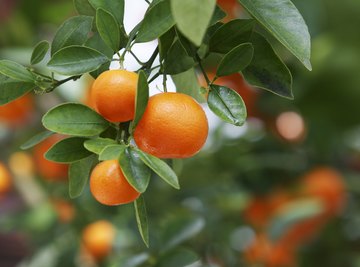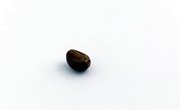
Derived from the Latin root word -- fructus -- fruit is an old French word that roughly means a profit or income. While most people associate fruit with edible produce purchased in a grocery store, botanists have a narrower meaning for the word. In scientific terms, the fruit is the seed-bearing part of the plant formed after fertilization occurs.
Flower Development
Before a fruit can be formed, the flowers must bloom so the male and female parts can develop and produce pollen and receptive ovules. Within the flower, the stamens produce pollen, while the female ovules form inside a pistil. In most cases, the male stamens and female pistil occur within the same flower, but there are times where flowers will develop into male or female units on separate plants.
Pollen Travels
In most flowering plants, the pollen must travel to a different plant of the same species for fertilization to occur. Called cross-fertilization, this process ensures that the genetic offspring are not completely identical to the parent. Insects and the wind are the two most common means of transporting pollen to another plant, but flowers can also be pollinated by bats, birds, spiders, butterflies, moths or water. Self-pollination is rare, but does occur in a few plants.
Fertilizing the Ovule
Once the pollen arrives at the top of the pistil, the location of the stigma, it needs to travel down the pollen tube to the base of the pistil, where it can find a receptive ovule -- the female genetic material found inside the ovary. Once the pollen finds the ovule, the male and female genetic material combines to form an embryo, which eventually develops into a seed.
Seed Growth
Once the embryo forms, the cells of the embryo grow in a normal method. After the embryo grows beyond its two-cell stage, botanists call it a zygote. As time passes, the zygote grows larger. Eventually cell differentiation begins and the zygote begins to change into a seed.
Fruit Development
Once the zygote starts to grow, the ovary begins developing into a fruit and the ovules begin to form seeds. The outside wall of the ovary and pistil becomes the skin of the fruit, or in some cases like the apple and pear, there develops a fleshy and edible material outside the ovary wall which becomes the edible part of the fruit. This fleshy material is then covered by an outer covering that derives from the petals, sepals and bracts. In either case, the fruit grows as long as the plant does, but eventually falls when the fruit ripens or the plant goes dormant for the winter.
References
About the Author
Henri Bauholz is a professional writer covering a variety of topics, including hiking, camping, foreign travel and nature. He has written travel articles for several online publications and his travels have taken him all over the world, from Mexico to Latin America and across the Atlantic to Europe.
